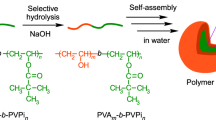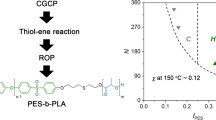Abstract
The microphase separation of double-hydrophilic block copolymers in water is of interest when these copolymers are utilized as molecular assemblies with mesoscale aqueous compartments. Diblock copolymers composed of a water-soluble zwitterionic polymer, poly(carboxybetaine acrylate) (PCBA2), and a hydrophilic water-insoluble nonionic polymer, poly(2-methoxyethyl acrylate) (PMEA), (PCBA2n-b-PMEAm) were synthesized, and their assembly characteristics were investigated in aqueous solutions. Well-defined PCBA2n-b-PMEAm block copolymers were synthesized by the reversible addition–fragmentation chain transfer polymerization of a carboxybetaine acrylate modified with a tert-butyl group and 2-methoxyethyl acrylate followed by tert-butyl group cleavage. PCBA2n-b-PMEAm produced particles in dilute aqueous solutions and microphase-separated structures in concentrated aqueous solutions. The hydrodynamic radius of the particles and the microphase-separated structure were associated with the block copolymer composition and degree of polymerization of the PMEA chain. The molecular assembly behavior was tolerant to NaCl concentration, providing molecular design guidelines for the use of double-hydrophilic microphase-separated compartments in physiological environments.
This is a preview of subscription content, access via your institution
Access options
Subscribe to this journal
Receive 12 print issues and online access
$259.00 per year
only $21.58 per issue
Buy this article
- Purchase on Springer Link
- Instant access to full article PDF
Prices may be subject to local taxes which are calculated during checkout






Similar content being viewed by others
References
Keating CD. Aqueous phase separation as a possible route to compartmentalization of biological molecules. Acc Chem Res. 2012;45:2114–24.
Long MS, Jones CD, Helfrich MR, Mangeney-Slavin LK, Keating CD. Dynamic microcompartmentation in synthetic cells. PNAS. 2005;102:5920–5.
Mace CR, Akbulut O, Kumar AA, Shapiro ND, Derda R, Patton MR, et al. Aqueous multiphase systems of polymers and surfactants provide self-assembling step-gradients in density. J Am Chem Soc. 2012;134:9094–7.
Hamley IW. Block copolymers in solution: Fundamentals and applications. Chichester, England: John Wiley & Sons, Ltd.; 2005.
Zhao H, Ibrahimova V, Garanger E, Lecommandoux S. Dynamic spatial formation and distribution of intrinsically disordered protein droplets in macromolecularly crowded protocells. Angew Chem. 2020;132:11121–9.
Sakuta H, Fujita F, Hamada T, Hayashi M, Takiguchi K, Tsumoto K, et al. Self-emergent protocells generated in an aqueous solution with binary macromolecules through liquid-liquid phase separation. ChemBioChem. 2020;21:3323–8.
Shono M, Ito R, Fujita F, Sakuta H, Yoshikawa K. Emergence of uniform linearly‑arranged micro‑droplets entrapping DNA and living cells through water/water phase‑separation. Sci Rep. 2021;11:23570.
Schmidt BVKJ. Double hydrophilic block copolymer self-assembly in aqueous solution. Macromol Chem Phys. 2018;219:1700494.
Casse O, Shkilnyy A, Linders Jr, Mayer C, Häussinger D, Völkel A, et al. Solution behavior of double-hydrophilic block copolymers in dilute aqueous solution. Macromolecules 2012;45:4772–7.
Taubert A, Furrer E, Meier W Water-in-water mesophases for templating inorganics. Chem Commun. 2004;2170–1. https://pubs.rsc.org/en/content/articlelanding/2004/cc/b405610h/unauth.
Blanazs A, Warren NJ, Lewis AL, Armes SP, Ryan AJ. Self-assembly of double hydrophilic block copolymers in concentrated aqueous solution. Soft Matter. 2011;7:6399.
Willersinn J, Schmidt BVKJ. Self-assembly of double hydrophilic poly(2-ethyl-2-oxazoline)-b-poly(n-vinylpyrrolidone) block copolymers in aqueous solution. Polymers. 2017;9:293.
Oh T, Nagao M, Hoshino Y, Miura Y. Self-assembly of a double hydrophilic block glycopolymer and the investigation of its mechanism. Langmuir. 2018;34:8591–8.
Brosnan SM, Schlaad H, Antonietti M. Aqueous self-assembly of purely hydrophilic block copolymers into giant vesicles. Angew Chem Int Ed. 2015;54:9715–8.
Lira RB, Willersinn J, Schmidt BVKJ, Dimova R. Selective partitioning of (biomacro)molecules in the crowded environment of double-hydrophilic block copolymers. Macromolecules. 2020;53:10179–88.
Rodríguez-Hernández J, Lecommandoux S. Reversible inside-out micellization of pH-responsive and water-soluble vesicles based on polypeptide diblock copolymers. J Am Chem Soc. 2005;127:2026–7.
Takahashi M, Shimizu A, Yusa S-I, Higaki Y. Lyotropic morphology transition of double zwitterionic diblock copolymer aqueous solutions. Macromol Chem Phys. 2021;222:2000377.
Shimizu A, Hifumi E, Kojio K, Takahara A, Higaki Y. Modulation of double zwitterionic block copolymer aggregates by zwitterion-specific interactions. Langmuir. 2021;37:14760–6.
Higaki Y, Takahashi M, Masuda T. Phase behavior of double zwitterionic block copolymers in water: Morphology transition through concentration dependent selectivity of water partitioning. Macromol Chem Phys. 2023;224:2200416.
Tanaka M, Hayashi T, Morita S. The roles of water molecules at the biointerface of medical polymers. Polym J. 2013;45:701–10.
Murakami D, Yamazoe K, Nishimura S-N, Kurahashi N, Ueda T, Miyawaki J, et al. Hydration mechanism in blood-compatible polymers undergoing phase separation. Langmuir. 2022;38:1090–8.
Tanaka M, Mochizuki A, Ishii N, Motomura T, Hatakeyama T. Study of blood compatibility with poly(2-methoxyethyl acrylate). Relationship between water structure and platelet compatibility in poly(2-methoxyethylacrylate-co-2-hydroxyethylmethacrylate). Biomacromolecules. 2002;3:36–41.
Li G, Ye S, Morita S, Nishida T, Osawa M. Hydrogen bonding on the surface of poly (2-methoxyethyl acrylate). J Am Chem Soc. 2004;126:12198–9.
Vancoillie G, Frank D, Hoogenboom R. Thermoresponsive poly(oligo ethylene glycol acrylates). Prog Polym Sci. 2014;39:1074–95.
Tsuji A, Nguyen TL, Mizoue Y, Ishihara K, Yusa S-I. Water-soluble polymer micelles formed from amphiphilic diblock copolymers bearing pendant phosphorylcholine and methoxyethyl groups. Polym J. 2021;53:805–14.
Nguyen TL, Kawata Y, Ishihara K, Yusa S-I Synthesis of amphiphilic statistical copolymers bearing methoxyethyl and phosphorylcholine groups and their self-association behavior in water. Polymers. 2020;12:1808–21.
Steinhauer W, Hoogenboom R, Keul H, Moeller M. Copolymerization of 2-hydroxyethyl acrylate and 2-methoxyethyl acrylate via raft: Kinetics and thermoresponsive properties. Macromolecules. 2010;43:7041–7.
Hoogenboom R, Zorn AM, Keul H, Barner-Kowollik C, Moeller M. Copolymers of 2-hydroxyethylacrylate and 2-methoxyethyl acrylate by nitroxide mediated polymerization: Kinetics, sec-esi-ms analysis and thermoresponsive properties. Polym Chem. 2012;3:335–42.
Li B, Yuan Z, Hung HC, Ma J, Jain P, Tsao C, et al. Revealing the immunogenic risk of polymers. Angew Chem Int Ed. 2018;57:13873–6.
Strobl GR, Schneider M. Direct evaluation of the electron density correlation function of partially crystalline polymers. J Polym Sci Polym Phys Ed. 1980;18:1343–59.
Vonk CG, Kortleve G. X-ray small-angle scattering of bulk polyethylene. Colloid Polym Sci. 1967;220:19–24.
Jesson CP, Pearce CM, Simon H, Werner A, Cunningham VJ, Lovett JR, et al. H2O2 enables convenient removal of raft end-groups from block copolymer nano-objects prepared via polymerization-induced self-assembly in water. Macromolecules. 2017;50:182–91.
Morita S, Tanaka M, Ozaki Y. Time-resolved in situ ATR-IR observations of the process of sorption of water into a poly(2-methoxyethyl acrylate) film. Langmuir. 2007;23:3750–61.
Nishida K, Nishimura SN, Tanaka M. Selective accumulation to tumor cells with coacervate droplets formed from a water-insoluble acrylate polymer. Biomacromolecules. 2022;23:1569–80.
Acknowledgements
This work was supported by JSPS KAKENHI Grant Number JP22H02147 (Grant-in-Aid for Scientific Research (B)) and JP22H04555, JP19H05714, JP19H05720 (Grant-in-Aid for Scientific Research on Innovative Area: Aquatic Functional Materials). YH acknowledges the Toshiaki Ogasawara Memorial Foundation for its financial support. This work was performed under the Cooperative Research Program of “Network Joint Research Center for Materials and Devices”. Synchrotron SAXS experiments were performed on the BL06 and BL11 beamlines at the SAGA Light Source (proposal numbers 2022IIK013, 2211113 F). The authors acknowledge Dr. M. Kawamoto for his assistance with the SAXS measurements. The authors gratefully acknowledge Prof. Emi Hifumi (Oita University) for her help in conducting the DLS measurements. The following supplementary information is available at the Polymer Journal website: measurements; synthesis of 2-(N-(2-acryloyloxyethyl)-N,N-dimethyl)ammonio)-1-(tert-butoxy)-1-oxoethane bromide (tert-BuCBA2); 1H-NMR spectrum of P(tert-BuCBA2)-CTA and PCBA2; appearance of PMEA76, PCBA229, and PCBA229-b-PMEA199 salt-free aqueous solutions; Rh distributions of PCBA2n-b-PMEAm in 150 mM NaCl aqueous solutions; correlation function profile for the PCBA233-b-PMEA146 60 wt% salt-free aqueous solution; phase contrast optical microscopy image of the coacervate droplets in PCBA233-b-PMEA146 solutions; and SAXS data for polymer concentration-dependent PCBA229-b-PMEA34 aggregation in salt-free aqueous solutions.
Author information
Authors and Affiliations
Corresponding author
Ethics declarations
Conflict of interest
The authors declare no competing interests.
Additional information
Publisher’s note Springer Nature remains neutral with regard to jurisdictional claims in published maps and institutional affiliations.
Supplementary information
Rights and permissions
Springer Nature or its licensor (e.g. a society or other partner) holds exclusive rights to this article under a publishing agreement with the author(s) or other rightsholder(s); author self-archiving of the accepted manuscript version of this article is solely governed by the terms of such publishing agreement and applicable law.
About this article
Cite this article
Higaki, Y., Toyama, H., Masuda, T. et al. Microphase separation of double-hydrophilic poly(carboxybetaine acrylate)-poly(2-methoxyethyl acrylate) block copolymers in water. Polym J 55, 1357–1365 (2023). https://doi.org/10.1038/s41428-023-00831-3
Received:
Revised:
Accepted:
Published:
Issue Date:
DOI: https://doi.org/10.1038/s41428-023-00831-3



